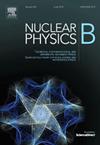Triple critical point and emerging temperature scales in SU(N) ferromagnetism at large N
IF 2.5
3区 物理与天体物理
Q2 PHYSICS, PARTICLES & FIELDS
引用次数: 0
Abstract
The non-Abelian ferromagnet recently introduced by the authors, consisting of atoms in the fundamental representation of , is studied in the limit where N becomes large and scales as the square root of the number of atoms n. This model exhibits additional phases, as well as two different temperature scales related by a factor . The paramagnetic phase splits into a “dense” and a “dilute” phase, separated by a third-order transition and leading to a triple critical point in the scale parameter and the temperature, while the ferromagnetic phase exhibits additional structure, and a new paramagnetic-ferromagnetic metastable phase appears at the larger temperature scale. These phases can coexist, becoming stable or metastable as temperature varies. A generalized model in which the number of -equivalent states enters the partition function with a nontrivial weight, relevant, e.g., when there is gauge invariance in the system, is also studied and shown to manifest similar phases, the dense-dilute phase transition becoming second-order in the fully gauge invariant case.
大 N 条件下 SU(N) 铁磁性的三临界点和新出现的温度尺度
作者最近提出的非阿贝尔铁磁体,由 SU(N) 基本表示中的原子组成,在 N 变大并以原子数 n 的平方根为标度的极限下进行了研究。该模型表现出额外的相位,以及两个不同的温度标度,其相关系数为 N/lnN。顺磁相分裂为 "致密 "相和 "稀释 "相,两者之间存在一个三阶转变,并导致尺度参数 n/N2 和温度的三重临界点。这些相可以共存,随着温度的变化而变得稳定或蜕变。我们还研究了一个广义模型,在该模型中,SU(N)等效态的数量以非微不足道的权重进入分配函数,例如,当系统中存在量规不变性时,该模型也表现出类似的相位,在完全量规不变的情况下,致密-稀释相变成为二阶相变。
本文章由计算机程序翻译,如有差异,请以英文原文为准。
求助全文
约1分钟内获得全文
求助全文
来源期刊

Nuclear Physics B
物理-物理:粒子与场物理
CiteScore
5.50
自引率
7.10%
发文量
302
审稿时长
1 months
期刊介绍:
Nuclear Physics B focuses on the domain of high energy physics, quantum field theory, statistical systems, and mathematical physics, and includes four main sections: high energy physics - phenomenology, high energy physics - theory, high energy physics - experiment, and quantum field theory, statistical systems, and mathematical physics. The emphasis is on original research papers (Frontiers Articles or Full Length Articles), but Review Articles are also welcome.
 求助内容:
求助内容: 应助结果提醒方式:
应助结果提醒方式:


